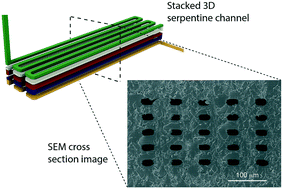Our official English website, www.x-mol.net, welcomes your
feedback! (Note: you will need to create a separate account there.)
Custom 3D printer and resin for 18 μm × 20 μm microfluidic flow channels
Lab on a Chip ( IF 6.1 ) Pub Date : 2017-07-14 00:00:00 , DOI: 10.1039/c7lc00644f Hua Gong 1, 2, 3, 4 , Bryce P. Bickham 1, 2, 3, 4 , Adam T. Woolley 2, 3, 4, 5 , Gregory P. Nordin 1, 2, 3, 4
Lab on a Chip ( IF 6.1 ) Pub Date : 2017-07-14 00:00:00 , DOI: 10.1039/c7lc00644f Hua Gong 1, 2, 3, 4 , Bryce P. Bickham 1, 2, 3, 4 , Adam T. Woolley 2, 3, 4, 5 , Gregory P. Nordin 1, 2, 3, 4
Affiliation

|
While there is great interest in 3D printing for microfluidic device fabrication, to-date the achieved feature sizes have not been in the truly microfluidic regime (<100 μm). In this paper we demonstrate that a custom digital light processor stereolithographic (DLP-SLA) 3D printer and a specifically-designed, low cost, custom resin can readily achieve flow channel cross sections as small as 18 μm × 20 μm. Our 3D printer has a projected image plane resolution of 7.6 μm and uses a 385 nm LED, which dramatically increases the available selection of UV absorbers for resin formulation compared to 3D printers with 405 nm LEDs. Beginning with 20 candidate absorbers, we demonstrate the evaluation criteria and process flow required to develop a high-resolution resin. In doing so, we introduce a new mathematical model for characterizing the resin optical penetration depth based only on measurement of the absorber's molar absorptivity. Our final resin formulation uses 2-nitrophenyl phenyl sulfide (NPS) as the UV absorber. We also develop a novel channel narrowing technique that, together with the new resin and 3D printer resolution, enables small flow channel fabrication. We demonstrate the efficacy of our approach by fabricating 3D serpentine flow channels 41 mm long in a volume of only 0.12 mm3, and by printing high aspect ratio flow channels <25 μm wide and 3 mm tall. These results indicate that 3D printing is finally positioned to challenge the pre-eminence of methods such as soft lithography for microfluidic device prototyping and fabrication.
中文翻译:

定制的3D打印机和用于18μm×20μm微流体流动通道的树脂
尽管对用于微流体装置制造的3D打印有很大的兴趣,但迄今为止,实现的特征尺寸还不是真正的微流体体系(<100μm)。在本文中,我们证明了定制数字光处理器立体光刻(DLP-SLA)3D打印机和专门设计的低成本定制树脂可以轻松实现小至18μm×20μm的流道横截面。我们的3D打印机具有7.6μm的投影图像平面分辨率,并使用385 nm LED,与具有405 nm LED的3D打印机相比,它大大增加了用于树脂配方的紫外线吸收剂的选择。从20种候选吸收剂开始,我们演示了开发高分辨率树脂所需的评估标准和工艺流程。在这样做,我们仅根据吸收体的摩尔吸收率的测量结果,介绍了一种用于表征树脂光学穿透深度的新数学模型。我们最终的树脂配方使用2-硝基苯基苯硫醚(NPS)作为紫外线吸收剂。我们还开发了一种新颖的通道收窄技术,与新的树脂和3D打印机分辨率一起,可实现小流量通道的制造。我们通过制造41毫米长,体积仅为0.12毫米的3D蛇形流动通道来证明我们的方法的有效性如图3所示,并通过打印宽宽比小于25μm,高3 mm的高长宽比流道。这些结果表明,3D打印最终将挑战微流控设备原型设计和制造的方法,例如软光刻技术。
更新日期:2017-08-22
中文翻译:

定制的3D打印机和用于18μm×20μm微流体流动通道的树脂
尽管对用于微流体装置制造的3D打印有很大的兴趣,但迄今为止,实现的特征尺寸还不是真正的微流体体系(<100μm)。在本文中,我们证明了定制数字光处理器立体光刻(DLP-SLA)3D打印机和专门设计的低成本定制树脂可以轻松实现小至18μm×20μm的流道横截面。我们的3D打印机具有7.6μm的投影图像平面分辨率,并使用385 nm LED,与具有405 nm LED的3D打印机相比,它大大增加了用于树脂配方的紫外线吸收剂的选择。从20种候选吸收剂开始,我们演示了开发高分辨率树脂所需的评估标准和工艺流程。在这样做,我们仅根据吸收体的摩尔吸收率的测量结果,介绍了一种用于表征树脂光学穿透深度的新数学模型。我们最终的树脂配方使用2-硝基苯基苯硫醚(NPS)作为紫外线吸收剂。我们还开发了一种新颖的通道收窄技术,与新的树脂和3D打印机分辨率一起,可实现小流量通道的制造。我们通过制造41毫米长,体积仅为0.12毫米的3D蛇形流动通道来证明我们的方法的有效性如图3所示,并通过打印宽宽比小于25μm,高3 mm的高长宽比流道。这些结果表明,3D打印最终将挑战微流控设备原型设计和制造的方法,例如软光刻技术。











































 京公网安备 11010802027423号
京公网安备 11010802027423号